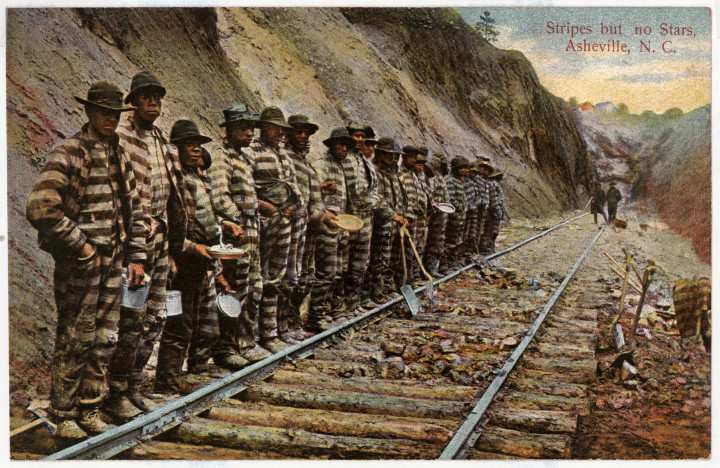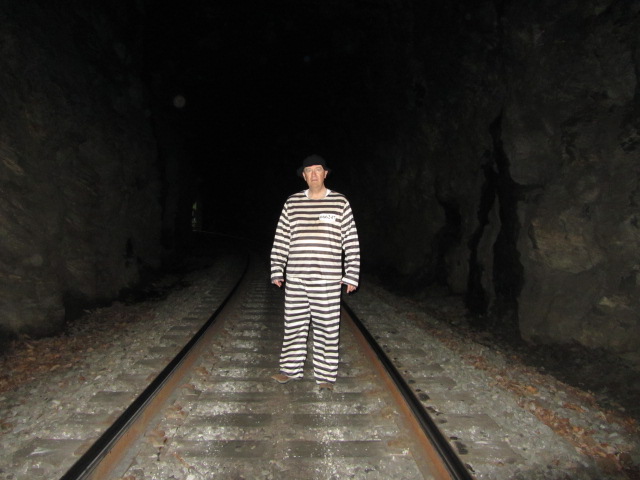One of the more peculiar icons of Americana is that of the “chain gang.” Hollywood has popularized the daily life and struggles of convict workers in films such as 1967’s Cool Hand Luke and the Coen Brother’s O Brother, Where Art Thou? Prison laborers are still seen to this day along highways across America.
But residents of Western North Carolina may not be aware that convicted felons played a large role in opening the isolated Southern Appalachians to the rest of the country through their work bringing the railroads into this region.
Steven Little, mayor of Marion, as well as author and railroad-lore aficionado has put together a one-man performance illustrating the daily life and experiences of the imprisoned men who hacked, hammered and blasted their way through the Swannanoa Gap in the late 1800s to connect Buncombe County with the eastern part of North Carolina.
Donning the traditional black and white stripes of the prison laborer, Little recreates the thoughts, words and emotions of the anonymous men tasked with conquering one of the world’s oldest mountain ranges. Xpress caught up with Little to discuss his research and interpretation of this largely untold aspect of local history, prior his dramatic performance at Mars Hill University’s Broyhill Chapel on Thursday, September 24.
Xpress: What sparked your interest in the history of the railroad in this region?
My interest was initially established when I was 11 or 12 years old. I used to come to summer camp at Camp Ridgecrest when I was a kid, and at night I would be in my bunk in the cabin, about a half mile from the railroad tracks. I would hear the sounds of the train as it would come up the mountain. It’s dark and everything is quiet except for the crickets and then you hear this train climbing the mountain. [It’s] just the most unusual and plaintive sound you can imagine.
When I was in high school, I read John Ehle’s book The Road. Then when I was a student at Wake Forest searching for a topic for my thesis, I came up with the construction of the railroad from Old Fort to Ridgecrest. That was one of the best decisions I ever made; it was so compelling for me.
I moved to Marion after finishing law school in 1977 and I would often talk about the railroad [at] civic clubs and church groups. People would tell me I needed to write this down. So finally, in 2009, I published a condensed history called Tunnels, Nitro, and Convicts.
Xpress: What was the reasoning behind using convict labor to build railroads regionally?
The concept of using convicts to perform labor was nothing new. The idea was: “These people need to be working [and] providing a benefit to the state. They’re not just going to come and sit while the taxpayers pay for their food and lodging and them do nothing.”
This became particularly important after the Civil War, because so many men were killed or wounded. The state had no money after the war, and then, even if they could come up with it, who was going to do the work? Convict labor met both of the criteria: They didn’t have to pay [convicts] anything, and they were available to do the work.
Xpress: Who were these convicts? Where did they come from?
Most were from down east, though some were local. They were about 90 percent African-American, largely because that was the prison population at the time. The character I portray came from Wilmington. I talk about getting off the box car and being terrified because I look up, and it looked like the world has exploded, until someone says, “Them’s is mountains” and I’m thinking, “How can there be such a thing as a mountain?” All I’d ever seen was flat ground down near the ocean.
There’s a whole list of offenses [they were jailed for]. It runs the gamut from breaking and entering, larceny, assault, murder, sexual offenses — everything you could imagine. Sometimes I would read the charge and wonder “What is that really?” There are words [in the records] that we just don’t use anymore. I’m going to include some of this material as appendices in the book I’m writing now — Railroad Convict.

Xpress: How important was Major James Wilson to the completion of the railroad through the Swannanoa Gap?
I think Major Wilson made the difference. He had an incredible amount of skill and talent, intelligence and the ability to work with people, even to inspire the uneducated, untrained, convicted criminals brought up to perform the labor. Not only did Major Wilson have to overcome the geographical challenges, the weather and the circumstances of having insufficient funds and convict labor as the primary workforce, but he had to deal with political attacks at the same time.
[He was] dealing with railroads, the center of political power during that time, and the legislature was suspicious of [that], charging him with various political activities and mismanagement. Of course, nothing was true about that; he was completely vindicated by the reports gathered by the investigative committee. Without any qualification, Major James W. Wilson is my hero in all of North Carolina history.
Xpress: In your research, did you come across many letters, notes, or other primary documents written by the prisoners?
There’s very, very little of that [extant]. I spent several years looking, but never finding. It’s not surprising that I never found much, because even the convicts’ names don’t appear [in records]. I found statistical data — total number of convicts that were shipped off to various work sites, including the Western North Carolina Railroad. I know the offenses [of the convicts]. I know that by far, there were more convicts sentenced to two-year sentences working out at various projects than for any other duration. Terms could be as short as six months. There were even a few lifers who were sent out.
The first convicts were shipped up in October of 1876 to a place called Henry Station, about two miles west of Old Fort. They had the task of cleaning out and cutting down trees to build the Round Knob Stockade, near where Andrews Geyser is today. One thing that I’m absolutely convinced is accurate, though I never found it written anywhere, is that the primary tool used by the convicts was a flat rock. The state couldn’t afford shovels, at least not that many.
Xpress: What were working conditions like?
The work and the conditions in which they had to do it were severe; it was brutal. For example, there was one occasion in the investigative interview reports where one investigator was critical because work had stopped due to two feet of snow on the ground. They thought these guys should be out working, which is ridiculous.
Of course, they could work in the tunnels even with bad weather. There were six tunnels within what was called the “mountain division,” plus one more between Old Fort and Henry Station.
Until a tunnel is finished, it’s nothing but a deep, dark cave. The tunnelers had the hardest job, going into these caves with these heavy sledgehammers, walking on uneven, slanted rock floors, pounding on this granite that’s been pressed together since God made the world. It’s dense, and surely, this must have been like knocking on the door to Hell.
In the presentation, I talk about this: what it sounded like inside, what it felt like, the experience.

Xpress: What can people nowadays learn from these convicts’ stories and experiences?
I think anybody attending my program comes away recognizing the existence of respect [during the construction] — that Major Wilson, particularly, was respectful to the convicts. That’s something that seems to be missing in so much of modern culture.
Now, the guards — I’m not so favorable talking about the guards. One of the first things [convicts] learned at Central Prison is there’s really not much difference between the guards and anybody else inside the building. They’re not smart, but they’re white and they’ve got a gun and a uniform, and that’s how come they’re the boss man.
I think it’s interesting to think about today, how we as a culture are more accepting of people of all races and backgrounds and yet, we’re not connected. You see a group of four or five people together and they’re all looking at their own individual cellphones. It’s like being in some sort of surrealistic image of people who aren’t being people.
What I try to convey in my presentation is the respect for each other at a time when you had to cooperate. Even when they were being transported from Central Prison to Henry Station, they were connected, handcuffed to the person beside them on each side in groups of five and leg-shackled. They’re on a boxcar and in one corner, there’s a hole in the floor for “necessary purposes.” It’s night and people are trying to sleep, and then you’ve got a guy who has to go to the bathroom. He’s attached to four other guys — they all got to go to the hole, whether they need to use it or not.
I try to make the people listening aware of how difficult it was for the convicts and how they had to adapt. I don’t want people to have their souls crushed as they listen, but I want them to realize that this was horrible, just absolutely horrible. Yet they persevered.
Steven Little will perform his presentation, “Railroad Convict,” on Thursday, Sept. 24 at 7 p.m. at the Broyhill Chapel at Mars Hill.






The photo at the top of this article from my collection has nothing whatsoever to do with the building of the railroad from Old Fort to Ridgecrest or anywhere else. That is a picture of a train crew for Norwood Lumber Company at Forney, NC. The engineer holding the oil can on the left is Noah Haney. The names of the fireman and two brakemen are not known. They are standing behind Norwood Lumber Climax Locomotive #5.
Hi Mr. Ledford. Thank you for sharing! I apologize for the misidentification regarding the photo, and appreciate the clarification. I’ve removed the photo to prevent further confusion.
I’ve been trying to find a color postcard like the one of the convicts standing along the tracts in the article. Can anyone help ? Paul
Prifkin@aol.com